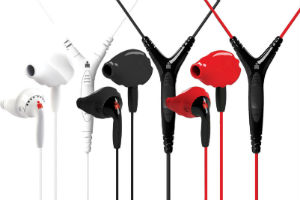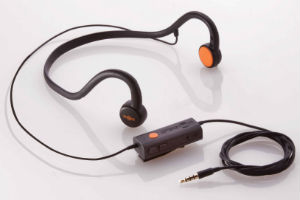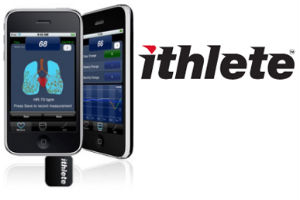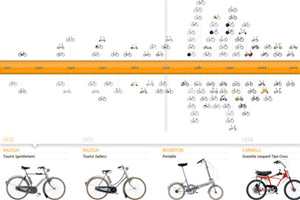 Renowned manufacturer of bike systems and riders’ equipment Mavic, based in Annecy, France, has been an official partner and sponsor of the Tour de France since the 1970s. Founded in 1889 – their name an acronym for ‘Manufacture d’Articles Vélocipédiques Idoux et Chanel’ (phew) – it’s fair to say they know a thing or two about the sport and with their first carbon clinchers, the Mavic Cosmic Carbone 40 C Wheels, fresh to market Cyclo were naturally eager to put them through their paces.
Renowned manufacturer of bike systems and riders’ equipment Mavic, based in Annecy, France, has been an official partner and sponsor of the Tour de France since the 1970s. Founded in 1889 – their name an acronym for ‘Manufacture d’Articles Vélocipédiques Idoux et Chanel’ (phew) – it’s fair to say they know a thing or two about the sport and with their first carbon clinchers, the Mavic Cosmic Carbone 40 C Wheels, fresh to market Cyclo were naturally eager to put them through their paces.
Three years in development, The Cosmic is a wheel-tyre system, which comes with slim Yksion Pro tyres (190g each), inner tubes, skewers and wheel bags. They have high stiffness, carbon/alloy hubs with aero flanges, integrated nipples and weigh 1,545g for a 40mm-deep pair (front wheel: 670g, front wheel with tyre – WTS: 940g) and 2,085g for the pair of wheels with tyres. But it’s not the weight (there are lighter clingers available) that sets them apart.
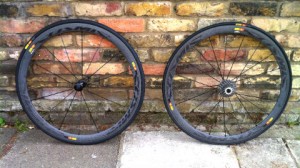 There are two recognised difficulties in developing a carbon fibre rim for a clincher; the first is the resistance of the sidewalls to the pressure of the tyre and the second is the resistance of the brake track to the heat created by braking. Whilst an aluminum rim is able to dissipate heat relatively quickly and aluminum resists very high temperatures, that is not the case for carbon fibre (and especially for the resin holding it together) and this inability to resist the heat can tend to cause softening and the failure of the sidewalls.
There are two recognised difficulties in developing a carbon fibre rim for a clincher; the first is the resistance of the sidewalls to the pressure of the tyre and the second is the resistance of the brake track to the heat created by braking. Whilst an aluminum rim is able to dissipate heat relatively quickly and aluminum resists very high temperatures, that is not the case for carbon fibre (and especially for the resin holding it together) and this inability to resist the heat can tend to cause softening and the failure of the sidewalls.
Mavic’s solution: a combination of an aluminum insert (completely different from a normal rim) with carbon fibre, which uses a resin able to withstand very high temperatures. Two types of resins are used on the brake track, each one having its own glass transition temperature. Mavic’s Maximum Glass Transition Temperature TgMAX technology consists of laying up several types of high technology resins, then fixing them using a proprietary heat treatment process to achieve the highest possible resistance to braking heat. In addition the manufacturing process, Mavic say, allows them to drill only the inner rim wall and not the aluminum insert, this avoids having to drill the tyre bed of the rim, making for a stronger rim as the inside is left uncompromised by holes.
Mavic tested the Cosmics with a 100kg rider on a 10km downhill section of Mount Ventoux in the Alps, riding at a consistently high speed whilst constantly applying the brakes. They measured the heat inside the rim with a T° patch and each sample had to withstand multiple descents. Whilst Cyclo lacked both the Alps and a 100kg rider (we’ll admit to 70kg), we set about testing the Cosmics…
 Having fitted the yellow carbon rim brake pads (which Mavic supplied with the wheels) to our Specialized Transition time trial bike we took the Cosmics out for a ride over a mix of fast flat and hilly terrain. The Cosmics felt stiff and light when we climbed steep, winding ascents and certainly much easier to climb with than our normal day-to-day wheel (Easton EA90 SLX), a relatively light wheel (1,398g for the wheelset without tyres). Descending relatively short but steep and fast technical descents in dry conditions we found the brakes to be very efficient when applying the pressure needed.
Having fitted the yellow carbon rim brake pads (which Mavic supplied with the wheels) to our Specialized Transition time trial bike we took the Cosmics out for a ride over a mix of fast flat and hilly terrain. The Cosmics felt stiff and light when we climbed steep, winding ascents and certainly much easier to climb with than our normal day-to-day wheel (Easton EA90 SLX), a relatively light wheel (1,398g for the wheelset without tyres). Descending relatively short but steep and fast technical descents in dry conditions we found the brakes to be very efficient when applying the pressure needed.
On the flat it felt like the Cosmics really came into their own. Certainly over the shorter distance they felt nimble and quick to accelerate, and when we pulled into a sprint the sensation of speed was exceptional. What’s more we found that we could maintain the sprint for longer than usual; whether this was a mix of strong legs on the day combined with the wheels, only time will tell, but the Cosmics certainly delivered a very smooth ride and more than met our expectations.
The Mavic Cosmic Carbone 40 C wheel-tyre system has an RRP of £1,800, more details at mavic.com or see the video below…


